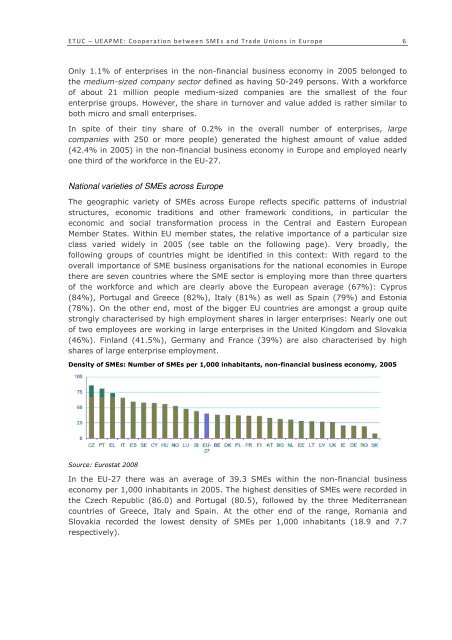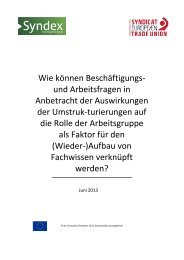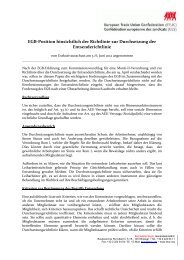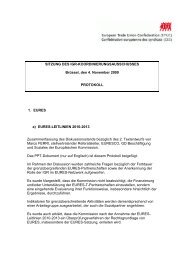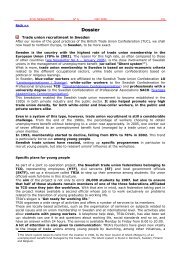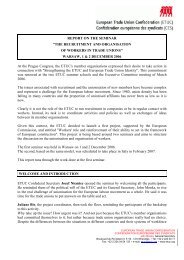Cooperation between SMEs and trade unions in Europe on ... - ETUC
Cooperation between SMEs and trade unions in Europe on ... - ETUC
Cooperation between SMEs and trade unions in Europe on ... - ETUC
You also want an ePaper? Increase the reach of your titles
YUMPU automatically turns print PDFs into web optimized ePapers that Google loves.
<strong>ETUC</strong> – UE APME: <str<strong>on</strong>g>Cooperati<strong>on</strong></str<strong>on</strong>g> betw een <str<strong>on</strong>g>SMEs</str<strong>on</strong>g> <str<strong>on</strong>g>and</str<strong>on</strong>g> Trade Unio ns <str<strong>on</strong>g>in</str<strong>on</strong>g> <str<strong>on</strong>g>Europe</str<strong>on</strong>g> 6<br />
Only 1.1% of enterprises <str<strong>on</strong>g>in</str<strong>on</strong>g> the n<strong>on</strong>-f<str<strong>on</strong>g>in</str<strong>on</strong>g>ancial bus<str<strong>on</strong>g>in</str<strong>on</strong>g>ess ec<strong>on</strong>omy <str<strong>on</strong>g>in</str<strong>on</strong>g> 2005 bel<strong>on</strong>ged to<br />
the medium-sized company sector def<str<strong>on</strong>g>in</str<strong>on</strong>g>ed as hav<str<strong>on</strong>g>in</str<strong>on</strong>g>g 50-249 pers<strong>on</strong>s. With a workforce<br />
of about 21 milli<strong>on</strong> people medium-sized companies are the smallest of the four<br />
enterprise groups. However, the share <str<strong>on</strong>g>in</str<strong>on</strong>g> turnover <str<strong>on</strong>g>and</str<strong>on</strong>g> value added is rather similar to<br />
both micro <str<strong>on</strong>g>and</str<strong>on</strong>g> small enterprises.<br />
In spite of their t<str<strong>on</strong>g>in</str<strong>on</strong>g>y share of 0.2% <str<strong>on</strong>g>in</str<strong>on</strong>g> the overall number of enterprises, large<br />
companies with 250 or more people) generated the highest amount of value added<br />
(42.4% <str<strong>on</strong>g>in</str<strong>on</strong>g> 2005) <str<strong>on</strong>g>in</str<strong>on</strong>g> the n<strong>on</strong>-f<str<strong>on</strong>g>in</str<strong>on</strong>g>ancial bus<str<strong>on</strong>g>in</str<strong>on</strong>g>ess ec<strong>on</strong>omy <str<strong>on</strong>g>in</str<strong>on</strong>g> <str<strong>on</strong>g>Europe</str<strong>on</strong>g> <str<strong>on</strong>g>and</str<strong>on</strong>g> employed nearly<br />
<strong>on</strong>e third of the workforce <str<strong>on</strong>g>in</str<strong>on</strong>g> the EU-27.<br />
Nati<strong>on</strong>al varieties of <str<strong>on</strong>g>SMEs</str<strong>on</strong>g> across <str<strong>on</strong>g>Europe</str<strong>on</strong>g><br />
The geographic variety of <str<strong>on</strong>g>SMEs</str<strong>on</strong>g> across <str<strong>on</strong>g>Europe</str<strong>on</strong>g> reflects specific patterns of <str<strong>on</strong>g>in</str<strong>on</strong>g>dustrial<br />
structures, ec<strong>on</strong>omic traditi<strong>on</strong>s <str<strong>on</strong>g>and</str<strong>on</strong>g> other framework c<strong>on</strong>diti<strong>on</strong>s, <str<strong>on</strong>g>in</str<strong>on</strong>g> particular the<br />
ec<strong>on</strong>omic <str<strong>on</strong>g>and</str<strong>on</strong>g> social transformati<strong>on</strong> process <str<strong>on</strong>g>in</str<strong>on</strong>g> the Central <str<strong>on</strong>g>and</str<strong>on</strong>g> Eastern <str<strong>on</strong>g>Europe</str<strong>on</strong>g>an<br />
Member States. With<str<strong>on</strong>g>in</str<strong>on</strong>g> EU member states, the relative importance of a particular size<br />
class varied widely <str<strong>on</strong>g>in</str<strong>on</strong>g> 2005 (see table <strong>on</strong> the follow<str<strong>on</strong>g>in</str<strong>on</strong>g>g page). Very broadly, the<br />
follow<str<strong>on</strong>g>in</str<strong>on</strong>g>g groups of countries might be identified <str<strong>on</strong>g>in</str<strong>on</strong>g> this c<strong>on</strong>text: With regard to the<br />
overall importance of SME bus<str<strong>on</strong>g>in</str<strong>on</strong>g>ess organisati<strong>on</strong>s for the nati<strong>on</strong>al ec<strong>on</strong>omies <str<strong>on</strong>g>in</str<strong>on</strong>g> <str<strong>on</strong>g>Europe</str<strong>on</strong>g><br />
there are seven countries where the SME sector is employ<str<strong>on</strong>g>in</str<strong>on</strong>g>g more than three quarters<br />
of the workforce <str<strong>on</strong>g>and</str<strong>on</strong>g> which are clearly above the <str<strong>on</strong>g>Europe</str<strong>on</strong>g>an average (67%): Cyprus<br />
(84%), Portugal <str<strong>on</strong>g>and</str<strong>on</strong>g> Greece (82%), Italy (81%) as well as Spa<str<strong>on</strong>g>in</str<strong>on</strong>g> (79%) <str<strong>on</strong>g>and</str<strong>on</strong>g> Est<strong>on</strong>ia<br />
(78%). On the other end, most of the bigger EU countries are am<strong>on</strong>gst a group quite<br />
str<strong>on</strong>gly characterised by high employment shares <str<strong>on</strong>g>in</str<strong>on</strong>g> larger enterprises: Nearly <strong>on</strong>e out<br />
of two employees are work<str<strong>on</strong>g>in</str<strong>on</strong>g>g <str<strong>on</strong>g>in</str<strong>on</strong>g> large enterprises <str<strong>on</strong>g>in</str<strong>on</strong>g> the United K<str<strong>on</strong>g>in</str<strong>on</strong>g>gdom <str<strong>on</strong>g>and</str<strong>on</strong>g> Slovakia<br />
(46%). F<str<strong>on</strong>g>in</str<strong>on</strong>g>l<str<strong>on</strong>g>and</str<strong>on</strong>g> (41.5%), Germany <str<strong>on</strong>g>and</str<strong>on</strong>g> France (39%) are also characterised by high<br />
shares of large enterprise employment.<br />
Density of <str<strong>on</strong>g>SMEs</str<strong>on</strong>g>: Number of <str<strong>on</strong>g>SMEs</str<strong>on</strong>g> per 1,000 <str<strong>on</strong>g>in</str<strong>on</strong>g>habitants, n<strong>on</strong>-f<str<strong>on</strong>g>in</str<strong>on</strong>g>ancial bus<str<strong>on</strong>g>in</str<strong>on</strong>g>ess ec<strong>on</strong>omy, 2005<br />
Source: Eurostat 2008<br />
In the EU-27 there was an average of 39.3 <str<strong>on</strong>g>SMEs</str<strong>on</strong>g> with<str<strong>on</strong>g>in</str<strong>on</strong>g> the n<strong>on</strong>-f<str<strong>on</strong>g>in</str<strong>on</strong>g>ancial bus<str<strong>on</strong>g>in</str<strong>on</strong>g>ess<br />
ec<strong>on</strong>omy per 1,000 <str<strong>on</strong>g>in</str<strong>on</strong>g>habitants <str<strong>on</strong>g>in</str<strong>on</strong>g> 2005. The highest densities of <str<strong>on</strong>g>SMEs</str<strong>on</strong>g> were recorded <str<strong>on</strong>g>in</str<strong>on</strong>g><br />
the Czech Republic (86.0) <str<strong>on</strong>g>and</str<strong>on</strong>g> Portugal (80.5), followed by the three Mediterranean<br />
countries of Greece, Italy <str<strong>on</strong>g>and</str<strong>on</strong>g> Spa<str<strong>on</strong>g>in</str<strong>on</strong>g>. At the other end of the range, Romania <str<strong>on</strong>g>and</str<strong>on</strong>g><br />
Slovakia recorded the lowest density of <str<strong>on</strong>g>SMEs</str<strong>on</strong>g> per 1,000 <str<strong>on</strong>g>in</str<strong>on</strong>g>habitants (18.9 <str<strong>on</strong>g>and</str<strong>on</strong>g> 7.7<br />
respectively).


